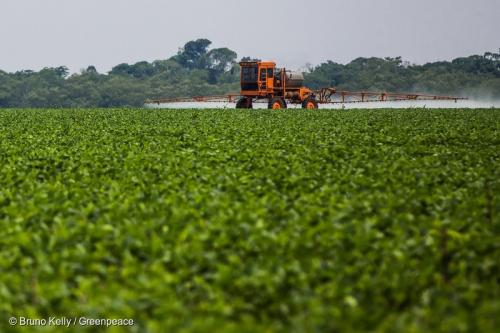Neonicotinoids bigger threat to wild bees and other animals than previously thought
Limits of partial EU ban exposed
Neonicotinoid pesticides pose serious risks not only to honeybees, but also to many other species, according to a scientific review published by Greenpeace, on January 12.

The analysis, conducted by scientists at the University of Sussex, reviewed new data from hundreds of studies published since the 2013 adoption of a partial EU ban on the pesticides clothianidin, imidacloprid and thiamethoxam. Scientists found risks for honeybees, bumblebees, butterflies and water insects, with possible ripple effects through the food chain. Based on the new findings, Greenpeace is urging the European Commission to fully ban neonicotinoids and promote ecological alternatives.
Dave Goulson, professor of biology and leading European expert on the ecology of bumblebees said: “The case that neonicotinoids are contributing to wild bee declines and exacerbating honeybee health issues is stronger than it was when the partial EU ban was adopted. In addition to bees, neonicotinoids can plausibly be linked to declines of butterflies, birds and aquatic insects. Given evidence for such widespread environmental harm it would seem prudent to extend the scope of the current European restriction.”
Marco Contiero, policy director on agriculture at Greenpeace EU, said: “How much more damage has to be done before the EU bans these pesticides? Science clearly shows that neonicotinoids are omnipresent and persistent in the wider environment, not just in agricultural fields. These substances are routinely found in soils, waterways and wildflowers. We must get rid of potent neurotoxins like neonicotinoids from our fields and environment. ”
The report confirms that neonicotinoids pose significant risks to many species, such as farmland butterflies, beetles, water insects and even birds such as house sparrows and partridges. Water insects get exposed as a result of neonicotinoids leaching from agricultural soils, drifting from sowing and spraying machines, and from water systems in greenhouses.
******************
The European Union restricted certain uses of clothianidin, imidacloprid and thiamethoxam in May 2013, based on assessments by the European Food Safety Authority (EFSA), which found that these pesticides are harmful to bees. As part of the decision to introduce a partial ban, the EU required that the producers of the substances submit further information on aspects for which EFSA could not conclude its assessment. On the basis of industry studies, EFSA confirmed in November 2016 that all authorised uses of imidacloprid and clothianidin pose a high risk to bees, or that a high risk cannot be excluded. In the case of thiamethoxam, Syngenta has already failed to produce the additional studies needed to back up an EU approval.
Source: Greenpeace EU Unit
- 361 reads
Human Rights
Fostering a More Humane World: The 28th Eurasian Economic Summi

Conscience, Hope, and Action: Keys to Global Peace and Sustainability

Ringing FOWPAL’s Peace Bell for the World:Nobel Peace Prize Laureates’ Visions and Actions

Protecting the World’s Cultural Diversity for a Sustainable Future

Puppet Show I International Friendship Day 2020

